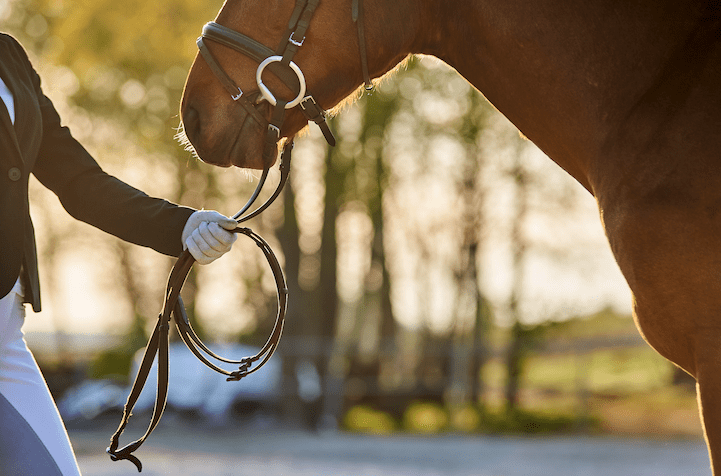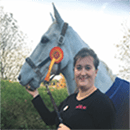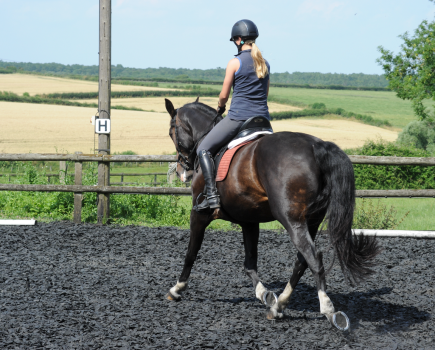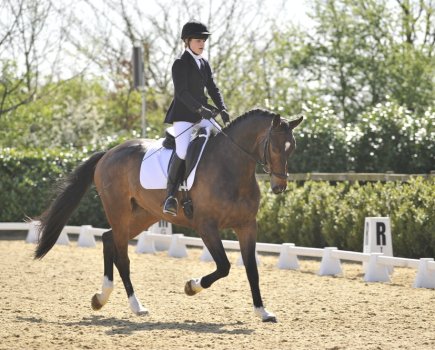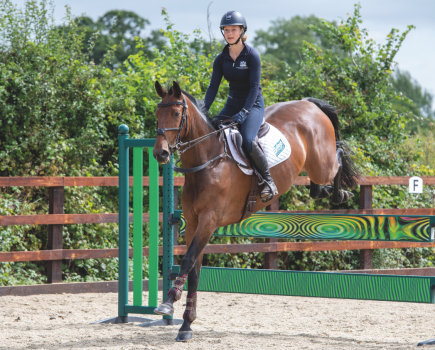There are numerous groundwork exercises for horses to build trust that you can do — and spending time doing them can be a very rewarding experience as it does wonders for your bond and relationship. When you stop to think about it, how much time do you actually spend working with your horse on the ground?
I’m not talking about grooming, leading to the field and other day-to-day yard jobs, but an actual training session without you in the saddle. I’ll admit that nearly all the exercise my horse gets involves me being on top or with him at the end of a lunge line — but groundwork for horses doesn’t have to mean lunging a horse.
Finding other ways to work with your horse on the ground is a great way to set solid foundations for riding, as well as build trust and confidence in your relationship, regardless of the horse’s age and experience.
Watching how your horse moves their feet helps identify any stiffness on one side and how they look when they move.
Crucially, working together in this way also helps fine-tune the bond between you and your horse, and there are plenty of groundwork exercises for horses that you can use to build trust (more on this later).
Things you’ll learn from groundwork
- It builds mutual confidence and trust between horse and owner, and you will be more confident when facing new challenges, like encountering unusual objects out hacking.
- You’ll start to understand your horse’s body language, and be able to read what they are thinking.
- It’s quality time together without pressure — perfect for bonding.
- Groundwork adds variety to your training. Variety is key to keeping boredom at bay.
- If your horse can’t be ridden for any reason, groundwork is a great way of engaging their brain and keeping them interested.
- All horses are capable of doing it, with plenty of encouragement.
- Your horse moves around in the stable a lot better. They’ll be way more aware of where you are on the ground if you work on your groundwork regularly — and less likely to step on your toes!
Groundwork exercises for horses to build trust
Generally, groundwork for horses can be done anywhere, and that is certainly true of this exercise from an equine behaviourist — try it in an indoor school, outdoor arena or a fenced off field.
Tack up your horse as usual but don’t mount. Take the reins over your horse’s head and lead them into your chosen work space. Aim to give the horse maximum freedom, so that they don’t feel held down or controlled by the reins.
All you do now is start walking randomly around your space. At the beginning, your horse will need some direction and clear aids to walk on, turn and whoa, so you should hold the reins reasonably short, like you would when leading around a busy lorry park at a competition.
Groundwork for horses: be the leader
To guide your horse, simply do what you want them to do, showing the way and leading by example. To walk on, start walking.
You may need to use your voice to indicate that you’d like the horse to start going forward with you. In a state of complete relaxation, horses prefer to follow a leader, so put yourself in front.
If your horse tries to pass you or is pulling hard, remain calm and ask them to whoa. Use your body language and voice to make it very clear to your horse what you are asking them to do.
With consistency, they will work it out. When you want to make a turn, simply turn and walk that way yourself.
Keep changing the rein
In this groundwork exercise you need to keep on changing direction. This means doing lots of circles and half loops of different sizes, changing the rein across the centre line and diagonals, and in both directions. Add in any other figures you can think of, such as a serpentine.
The purpose of all this is to bring your horse’s focus of attention on to you. If the track stays the same (either round the outside of your schooling area or a never-ending circle), your horse will get bored and their mind will wander.
Think of this groundwork exercise as being ‘scribbling’ for horses. Like a small child with a pen who can’t draw yet, you simply wander around in a random way.
Don’t do more than half a side of your arena (long or short) without making a change of some sort.
Groundwork exercises: Relax your hands
You should find that, after a while, your hand starts sliding down the reins almost by itself. What’s happening is that you and your horse are starting to feel comfortable with each other.
Your horse is beginning to understand this game and finding it easy. There’s nothing for them to worry about.
You, on the other hand, are thinking about the next move and where you’re going, and are no longer worrying about your horse. This is the best way for you to be with, and work with, your horse.
How long it takes for you to get to this state depends entirely on your horse and their level of nervousness or anxiety.
You may come to it within a few minutes, or it may take longer, but sliding your hand down the rein is part of the goal. However long it takes, stay with it until you feel that your horse is starting to relax and follow you about.
Groundwork for horses: halt
By now, you should be neither pulling your horse along, nor holding them back. They’re simply there, behind you.
When the horse seems to have got the idea and is settled enough, come to a standstill and show by example that you want them to halt.
Use a voice command, too, to reinforce the idea. Try the word ‘stand’, for example, or you can use any word you like — the key is to use it consistently.
Horses don’t find it easy to stop for no apparent reason, it goes against their basic instinct, which tells them to keep moving for most of the time. If they do walk on past you, give a light reminder with the reins. This should make the message clear.
Once the horse has stopped, start walking again and continue for a while. By now, your hand on the reins should be much lower down and the arm nearly in a normal, walking position.
When this happens, your horse is approaching submission. They’re going where you go and doing what you want. This means they’re totally relaxed and focused on you. It’s a lovely feeling!
Don’t overdo it
How long you do the above exercises for depends entirely on your horse and their level of anxiety, agitation or excitement. Most come to submission within 10 to 15 minutes.
Others may take longer, but 30 minutes should be plenty. If after half an hour you haven’t achieved relaxation and submission, end the session and start again another day.
Your horse should have the idea by then, so the second time should achieve the desired end result. Little and often is key, and horses learn through repetition so it is good to repeat an exercise over several days.
Groundwork for horses: pressure and release
According to classical dressage trainer Diane Thurman-Baker, who has competed to Grand Prix level and has over 30 years experience of working and training horses using classical training methods, groundwork exercises for horses are an important part of training a horse who is responsive, as well as to build trust in each other.
“Part of creating a responsive horse is the method of pressure and release,” she says. “If all the horses are at a water trough, they move out of the way when the alpha horse goes over. To have got to that point, the alpha horse will have nipped them on the flank first.”
Holding a schooling whip during a groundwork session enables you to recreate that pressure and release situation.
“Gently lay the lunge whip on your horse’s neck to stop them moving, and remove it when you want them to start moving,” explains Diane.
“Use a voice command, or a click, at the same time so your horse associates the physical aid with a voice aid. Aim for them to start working forward from behind, swinging through their back to create engagement and lightness.”
Four tips for getting results from groundwork
1 Watch your body language
Your horse needs to be confident in you before they start, so keep calm and remain patient, but be assertive — and always stand by your horse’s head so they can see you.
2 Practice and patience
Groundwork for horses is a prime opportunity to bond with each other, so don’t turn it into a fight by losing patience if they struggle to do what you’re asking. Some horses — like humans — are less nimble than others. Just take your time and reward the horse by taking the pressure off and praising them when they nail it.
3 Work in the middle
If your horse struggles with knowing where to place themselves, try to do all your groundwork exercises in the middle of your arena so they have plenty of space to move. Don’t risk them backing into your fence posts.
4 Go whipless
If you have a horse who is extremely nervous of a whip use your hand instead to apply and take away light pressure. This is a good alternative to the whip technique.
More groundwork exercises for horses to build trust
Confidence and familiarity work wonders for a nervy horse, which is why putting the time in to bond on the ground and build trust is so worthwhile. It means that in time your horse will fully trust you whatever the situation.
Diane, who runs Turville Valley Stud alongside her daughters Samantha and Joanna, both international dressage riders, suggests doing the following groundwork exercises for five minutes on each rein, three times a week.
Exercise 1: A simple start
- Start by gently laying the whip on your horse, teaching them to stand still when it’s on and to move as required when it’s taken off.
- For more energy in their movement, the whip is lightly tapped on the horse’s side or quarters. Twinned with a vocal command, or a click, the horse soon learns what’s required of them. Be clear in your commands and actions so they understand.
- Stand next to your horse so you are just in front of their eye and they can see what you’re doing. Gently stroke the whip over their body, talking soothingly as you do so. Then:
- Start with the whip on your horse’s withers. As you take it away, use your voice to ask them to walk forwards. To encourage them to do this, give a slight pull on the rein or flick with the whip on their side where your leg would be if you were riding.
- As they walk forwards, you take a step backwards. Walk at the horse’s pace, neither pulling them nor restricting their pace.
- As you gently place the whip back on your horse’s wither, asking them to stand still, use hand and voice commands to stop them.
- Do this on both reins, until your horse understands that a whip placed on their withers is the signal to stop. It normally takes three or four attempts, maybe longer, especially with a nervous horse. Remember horses learn through repetition, so repeating the exercise is key.
Exercise 2: Connect using poles
Adding poles to your groundwork helps your horse lift their legs up and become more aware of distances between poles.
It also creates the perfect opportunity for them to learn to be submissive. To start, simply get your horse to follow you around the arena on a loose rein and then over the poles.
There should be four or five poles in the middle of your arena around 4ft apart. Then:
- Starting in the middle of the arena, walk in front of your horse, slightly to one side so that you can see them.
- When your horse tries to pass you or stops, change direction.
- Repeat this three or four times before swapping sides and approaching the poles in the opposite direction.
- This exercise is simple, but effective for bonding. Your horse will need to trust you to take the lead and be submissive enough to follow you over the poles without rushing forward and breaking their stride.
Exercise 3: Work up to a shoulder-in
The next groundwork for horses step is shoulder-in. Horses who haven’t managed to build that stability in their movement will often kick in towards corners of the arena when ridden.
During this exercise, you want your horse’s inside hind leg to step under. In this position, you lead and drive the horse at the same time.
- Stand on the left side of your horse, with the whip on their neck to keep them still. Then remove it.
- Click, or use your voice, to ask your horse to move forwards a step or two with you, then indicate you want them to move sideways to their right by lightly tapping the whip against their left side.
- Aim for your horse to walk in a forward and sideways movement, in which the body bends laterally from neck to tail.
- Ask for a few steps of shoulder-in, then place the whip on their neck to stop them.
- Repeat this on the other rein.
This exercise gives your horse the opportunity to learn how to use and strengthen their back muscles.
Shoulder-in is beneficial to horses because it stretches both sides of the body and, by stretching and suppling their topline, it gradually makes it physically easier for them to do what you are asking of them.
Remember, don’t expect too much of your horse too soon. Start by asking for just one or a few steps and rewarding them for each one, building up to ask for more steps so that they cover more of the arena.
Groundwork improved our bond
When my ex-racehorse was returning to work after an injury, we quickly got fed up with doing laps of the arena.
The few sessions that we did try weren’t enjoyable for either of us, because he was only supposed to be walking and all he wanted to do was whizz around and expel some of the energy he had built up.
So I started walking him out in-hand instead. He particularly enjoyed this because I usually picked a route with a nice grassy verge he could safely stop and graze for a while.
Hacking in-hand was much more interesting for him, as he had plenty to look at, and it was far less stressful for me. So I’d say that is a win for both of us!
That time together was transformative: we’d wander along, me chatting, him sometimes turning his head to interact with me.
It progressed to more formal groundwork in the field and arena, walking over poles together, around cones — anything I could find to make it interesting.
I found that groundwork exercises for horses to build trust really do work — and do wonder for a person’s fitness too.
We still went into the arena on occasion, especially when he was able to trot. King actually became much easier to school after this because he was more relaxed in the arena (previously he would be tense and hang for home and take time to settle into a session).
I’ll confess that the groundwork sloped off when he could be ridden again, but we still enjoy it from time to time — especially when I haven’t got a lot of time to fit in some exercise between finishing work and doing the school run!
Main image © Shutterstock

